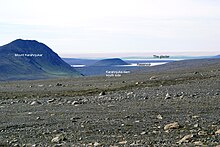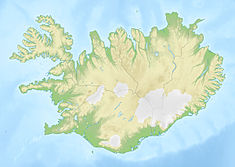| Revision as of 21:42, 31 August 2020 editÞjarkur (talk | contribs)Autopatrolled, Extended confirmed users38,913 edits added Category:Eastern Region (Iceland) using HotCat← Previous edit | Revision as of 15:03, 11 October 2020 edit undoWikiCleanerBot (talk | contribs)Bots928,066 editsm v2.03b - Bot 22 bogus-image-options - WP:WCW project (Bogus image options)Tag: WPCleanerNext edit → | ||
| Line 77: | Line 77: | ||
| == Construction == | == Construction == | ||
| ] | ] | ||
| ] leading water from Kárahnjúkar Dam to the power plant.]] | ] leading water from Kárahnjúkar Dam to the power plant.]] | ||
| The project is funded by ], which operates the dams and Fljótsdalur Power Station. The Italian company ] is the largest contractor working on the dams.<ref>The Icelandic contractor Suðurverk hf was the main contractor working on Desjará Dam and Sauðárdalur Dam {{webarchive|url=http://wayback.vefsafn.is/wayback/20041027171251/www.karahnjukar.is/EN/ |date=27 October 2004 }}</ref> The total cost of the hydropower project is 1.3 billion ]. The penstock was built in place by the ] company ] (Würzburg) whereas ATB Riva Calzoni of Italy provided intake structures, wheels gates and sliding gates. In total, more than 4,000 ]s of steel were used for the steel liner. | The project is funded by ], which operates the dams and Fljótsdalur Power Station. The Italian company ] is the largest contractor working on the dams.<ref>The Icelandic contractor Suðurverk hf was the main contractor working on Desjará Dam and Sauðárdalur Dam {{webarchive|url=http://wayback.vefsafn.is/wayback/20041027171251/www.karahnjukar.is/EN/ |date=27 October 2004 }}</ref> The total cost of the hydropower project is 1.3 billion ]. The penstock was built in place by the ] company ] (Würzburg) whereas ATB Riva Calzoni of Italy provided intake structures, wheels gates and sliding gates. In total, more than 4,000 ]s of steel were used for the steel liner. | ||
Revision as of 15:03, 11 October 2020
Dam
| Fljótsdalur Power Station Kárahnjúkar Dam | |
|---|---|
 Kárahnjúkar Dam, looking south. Kárahnjúkar Dam, looking south. | |
 Kárahnjúkar Dam in Iceland | |
| Country | Iceland |
| Coordinates | 64°56′N 15°48′W / 64.933°N 15.800°W / 64.933; -15.800 |
| Status | Operational |
| Opening date | 2009 |
| Dam and spillways | |
| Type of dam | Embankment, concrete-face rock-fill dams |
| Impounds | Jökulsá á Dal Jökulsá í Fljótsdal |
| Height | 193 m (633 ft) |
| Length | 730 m (2,400 ft) |
| Dam volume | 8.5×10 |
| Spillways | 1 |
| Spillway type | Tunnel |
| Reservoir | |
| Creates | Hálslón Reservoir |
| Total capacity | 2.1 km (1,700,000 acre⋅ft) |
| Maximum length | 25 km (16 mi) |
| Operator(s) | Landsvirkjun |
| Turbines | 6 x 115 MW (154,000 hp) Francis-type |
| Installed capacity | 690 MW |
| Annual generation | 4,600 GWh |
Kárahnjúkar Hydropower Plant (Template:Lang-is), officially called Fljótsdalur Power Station (Template:Lang-is) is a hydroelectric power plant in Fljótsdalshérað municipality in eastern Iceland, designed to produce 4,600 gigawatt-hours (17,000 TJ) annually for Alcoa's Fjarðaál aluminum smelter 75 kilometres (47 mi) to the east in Reyðarfjörður. With the installed capacity of 690 megawatts (930,000 hp), the plant is the largest power plant in Iceland. The project, named after the nearby Kárahnjúkar mountains, involves damming the rivers Jökulsá á Dal and Jökulsá í Fljótsdal with five dams, creating three reservoirs. Water from the reservoirs is diverted through 73 kilometres (45 mi) of underground water tunnels and down a 420-metre (1,380 ft) vertical penstock towards a single underground power station. The smelter became fully operational in 2008 and the hydropower project was completed in 2009.
The Kárahnjúkar Dam (Template:Lang-is) is the centrepiece of the five dams and the largest of its type in Europe, standing 193 metres (633 ft) tall with a length of 730 metres (2,400 ft) and comprising 8.5 million cubic metres (300×10^ cu ft) of material.
The project has been heavily criticised for its environmental impact and its use of foreign workers.
Description
The hydroelectricity project harnesses the rivers Jökulsá á Dal and Jökulsá í Fljótsdal by creating three reservoirs with five concrete-face rock-filled embankment dams; three on the Jökulsá á Dal and two on the Jökulsá í Fljótsdal. After being used in the Fljótsdalur Power Station, all water used in electricity production is discharged into the river Jökulsá í Fljótsdal.

Three dams on the Jökulsá á Dal; the Kárahnjúkar Dam (Template:Lang-is), the Desjará Dam (Template:Lang-is) and the Sauðárdalur Dam (Template:Lang-is) create the Hálslón Reservoir. At 193 metres (633 ft) tall and 730 metres (2,400 ft) long, the Kárahnjúkar Dam is the largest dam in the project and the largest of its type in Europe as well. The 60-metre (200 ft) tall and 1,000-metre (3,300 ft) long Desjará Dam and the 25-metre (82 ft) tall and 1,100-metre (3,600 ft) long Sauðárdalur Dam are saddle or auxiliary dams that maintain the desired height of the Hálslón Reservoir. Water from the 25-kilometre (16 mi) long, 2.1-cubic-kilometre (1,700,000 acre⋅ft) capacity Hálslón Reservoir (about the size of Manhattan island in New York) is diverted down a 39.7-kilometre (24.7 mi) long, 7.2–7.6-metre (24–25 ft) diameter headrace tunnel towards the Fljótsdalur Power Station.
On the river Jökulsá í Fljótsdal, the 26-metre (85 ft) tall and 1,650-metre (5,410 ft) long Kelduá Dam forms the 60-million-cubic-metre (2.1×10^ cu ft) capacity Kelduárlón Reservoir. Downstream from the Kelduá Dam is the 37-metre (121 ft) tall, 620-metre (2,030 ft) long Ufsarstífla dam which forms the Ufsarlón, a much smaller reservoir. Water from the Ufsarlón Reservoir is diverted down a 13.3-kilometre (8.3 mi) long, 6-metre (20 ft) diameter headrace tunnel where it joins the Hálslón Reservoir headrace tunnel.
Before each of the headrace tunnels from the Hálslón Reservoir or Ufsarlón Reservoir reach the underground power station, they both join to form a single combined headrace tunnel. The single headrace tunnel later splits into two 0.8-kilometre (0.50 mi) long, 4-metre (13 ft) diameter steel-lined penstocks (tunnels) and the water makes a rapid descent down a final 420-metre (1,380 ft) vertical penstock into the power station. The underground Fljótsdalur Power Station contains six vertical-axis Francis turbine generators rated at 115 MW each. The power station has a combined capacity of 690 MW and discharge of 144 cubic metres per second (5,100 cu ft/s) (averages 110 cubic metres per second (3,900 cu ft/s)) into the river Jökulsá í Fljótsdal via tailrace tunnels and canals. The power production of 4,600 GWh/year corresponds to a capacity factor of 76%, which is relatively high for a hydroelectric facility. Power produced is then transmitted to Alcoa's Fjarðaál aluminium smelter 75 kilometres (47 mi) to the east in Reyðarfjörður.
Fjarðaál aluminium smelter
Main article: Reyðarfjörður § Fjarðaál aluminium smelterThe Fjarðaál aluminium smelter was completed June 2007 and reached full operation in April 2008. Construction began in 2004 and the facility contains a smelter, cast house, rod production and deep-water port. The smelter employs 450 people and produces 940 tons of aluminium a day, with capacity of 346,000 metric tons of aluminium per year. Fjarðaál means "Fjords Aluminium" in Icelandic.
History
Using the rivers Jökulsá á Dal and Jökulsá í Fljótsdal along with other resources in eastern Iceland has been on the drawing board since the 1970s. From 1975-2002, several international companies had planned or attempted to build a metal plant at Reyðarfjörður that would be powered by a hydroelectricity project similar to the Kárahnjúkar. All failed because of opposition to the project until Alcoa along with the Government of Iceland and Landsvirkjun, Iceland's national power company committed to the massive project in 2002.
Construction


The project is funded by Landsvirkjun, which operates the dams and Fljótsdalur Power Station. The Italian company Impregilo is the largest contractor working on the dams. The total cost of the hydropower project is 1.3 billion USD. The penstock was built in place by the German company DSD-NOELL (Würzburg) whereas ATB Riva Calzoni of Italy provided intake structures, wheels gates and sliding gates. In total, more than 4,000 tons of steel were used for the steel liner.
Preparatory work on the project began in August 2002 and construction on the Kárahnjúkar Dam and headrace tunnels for the Hálslón Reservoir began in April 2003. In September of the same year, construction began on the underground power station. Construction on both the Desjará Dam and the Sauðárdalur Dam began in April 2004. In June 2006, construction of the Kelduá Dam and Ufsarstífla Dam began and in September, the Hálslón Reservoir began to fill. In mid-2008, the Kelduá and Ufsarstífla Dams were complete and the Ufsarlón Reservoir headrace tunnel was ready.
Construction on the headrace tunnels was done by three full-face tunnel boring machines, while remaining areas were drilled and blasted. This was the first time that tunnel boring machines were used in Iceland.
The project was documented in a MegaStructures program of the National Geographic Channel, and the Discovery Channel's Extreme Engineering, along with mention in the Sigur Rós 2006 documentary Heima (At Home), where the band played at a protest against the building of the dam.
There were several workplace fatalities during the construction process including: Arni Thor Bjarnason, Eilifur Gopi Hammond, Ludvik Alfred Halldorsson and Kresimir Durinic.
Criticism
The dams have been the frequent subject of protests by environmentalists for many reasons. The area is within the second largest (formerly) unspoiled wilderness in Europe and covers about 1,000 square kilometres (390 sq mi) in total and the rivers that supply water to the project are part of Europe's largest glacier, Vatnajökull. The project as a whole has also been criticised heavily in the book Draumalandið and subsequent 2009 documentary Dreamland. About 70% of the workforce was composed of foreign workers.
See also
References
- ^ "Fljótsdalur Power Station". www.landsvirkjun.com. Landsvirkjun, National Power Company of Iceland. Archived from the original on 13 July 2018. Retrieved 13 July 2018.
- ^ "Fljótsdalsstöð". www.landsvirkjun.is. Landsvirkjun, National Power Company of Iceland. Archived from the original on 13 July 2018. Retrieved 13 July 2018.
- Kárahnjúkar HEP - Landsvirkjun - September 2009 Archived 11 May 2011 at the Wayback Machine
- ^ Key Figures of the Kárahnjúkar Hydroelectric Project Archived 17 June 2011 at the Wayback Machine
- ^ The Kárahnjúkar Hydropower Project Overview Archived 17 June 2011 at the Wayback Machine
- "Alcoa - Fjarðaál smelter information". Archived from the original on 10 January 2011. Retrieved 2 January 2010.
- Large-scale industry in East Iceland Archived 17 June 2011 at the Wayback Machine
- The Icelandic contractor Suðurverk hf was the main contractor working on Desjará Dam and Sauðárdalur Dam Karahnjúkar website - Impregilo Archived 27 October 2004 at the National and University Library of Iceland
- Kárahnjúkar Construction Schedule Archived 3 March 2006 at the National and University Library of Iceland
- "Looking at tunnel roughness 3 April 2008". Archived from the original on 14 June 2011. Retrieved 2 January 2010.
- Veal, Lowana (2007) ICELAND: Dam Proves Fatal for Workers, IPS http://www.ipsnews.net/2007/01/iceland-dam-proves-fatal-for-workers/ Archived 24 August 2018 at the Wayback Machine
- "Iceland be Damned", Radio Netherlands Archives, February 8, 2003
- "Giant dam and smelter boost economy and raise tensions in Iceland". Archived from the original on 8 November 2007. Retrieved 2 January 2010.
External links
- Kárahnjúkar HEP Overview - Landsvirkjun - September 2009
- Anti-dam website
- Kárahnjúkar - 2005 - picture gallery from islandsmyndir.is
- Kárahnjúkar - 2006 - picture gallery from islandsmyndir.is
- Kárahnjúkar - 2007 A - picture gallery from islandsmyndir.is
- Kárahnjúkar - 2007 B - picture gallery from islandsmyndir.is
- Kárahnjúkar - 2008 - picture gallery from islandsmyndir.is
- Kárahnjúkar - Hringiða, 2011 - picture gallery from islandsmyndir.is
- Kárahnjúkar - Dams, 2011 - picture gallery from islandsmyndir.is
| Iceland articles | |||||||
|---|---|---|---|---|---|---|---|
| History |
|  | |||||
| Geography |
| ||||||
| Politics | |||||||
| Economy | |||||||
| Society |
| ||||||